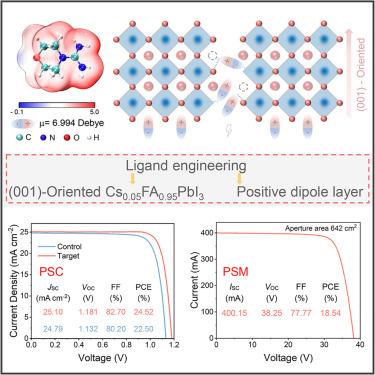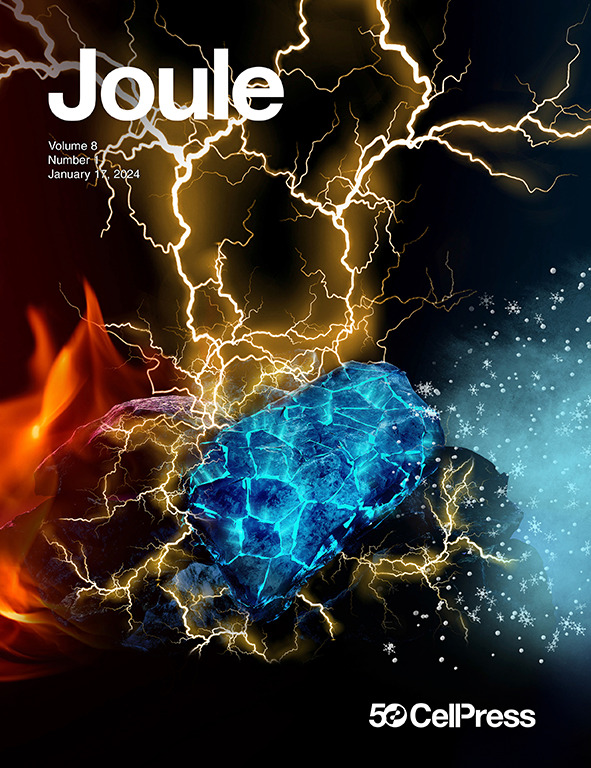Amidino-based ligand enables oriented crystallization and boosted carrier extraction for inverted perovskite solar cells and modules
IF 35.4
1区 材料科学
Q1 CHEMISTRY, PHYSICAL
引用次数: 0
Abstract
High-quality perovskite films with vertical orientation and compact bottom interface are critical for the design and engineering of efficient and stable CsxFA1−xPbI3-based perovskite solar cells (PSCs). Herein, a robust amidino-based ligand, namely morpholine-4-carboximidamide hydrochloride (M4CH), is introduced into the perovskite precursor to fabricate (001)-dominated perovskite films and simultaneously regulate buried interfacial morphologies and energetics. M4CH enables vertically oriented growth via its strongest adsorption energy on perovskite (001) facets. Concurrently, M4CH accumulates at the buried interface, forming a positive dipole layer to enhance carrier extraction. The resulting inverted methylammonium (MA)-free PSC achieves a champion power conversion efficiency (PCE) of 24.52%, an exceptionally high open-circuit voltage (VOC) of 1.181 V, and outstanding thermal and environmental stability. Encouragingly, the M4CH-incorporated module, with an aperture of 642 cm2, demonstrates an impressive efficiency of 18.54% (certified 18.48%), positioning it among the highest efficiencies recorded for large-scale inverted perovskite solar modules (PSMs).


氨基基配体实现了倒置钙钛矿太阳能电池和组件的定向结晶和载体提取
具有垂直取向和紧凑底界面的高质量钙钛矿薄膜对于设计和工程高效稳定的CsxFA1−xpbi3基钙钛矿太阳能电池(PSCs)至关重要。本文将一种健壮的氨基基配体,即盐酸morpholine-4-carboximidamide hydrochloride (M4CH),引入到钙钛矿前驱体中,制备(001)主导的钙钛矿薄膜,同时调节埋藏界面形态和能量学。M4CH通过其在钙钛矿(001)表面的最强吸附能实现垂直定向生长。同时,M4CH在埋藏界面处积聚,形成正偶极子层,增强载流子的提取。由此产生的无甲基铵(MA)的PSC具有24.52%的功率转换效率(PCE), 1.181 V的高开路电压(VOC),以及出色的热稳定性和环境稳定性。令人鼓舞的是,孔径为642 cm2的m4ch集成组件显示出令人印象深刻的18.54%(认证18.48%)的效率,使其成为大型倒置钙钛矿太阳能组件(psm)中记录的最高效率之一。
本文章由计算机程序翻译,如有差异,请以英文原文为准。
求助全文
约1分钟内获得全文
求助全文
来源期刊

Joule
Energy-General Energy
CiteScore
53.10
自引率
2.00%
发文量
198
期刊介绍:
Joule is a sister journal to Cell that focuses on research, analysis, and ideas related to sustainable energy. It aims to address the global challenge of the need for more sustainable energy solutions. Joule is a forward-looking journal that bridges disciplines and scales of energy research. It connects researchers and analysts working on scientific, technical, economic, policy, and social challenges related to sustainable energy. The journal covers a wide range of energy research, from fundamental laboratory studies on energy conversion and storage to global-level analysis. Joule aims to highlight and amplify the implications, challenges, and opportunities of novel energy research for different groups in the field.
 求助内容:
求助内容: 应助结果提醒方式:
应助结果提醒方式:


